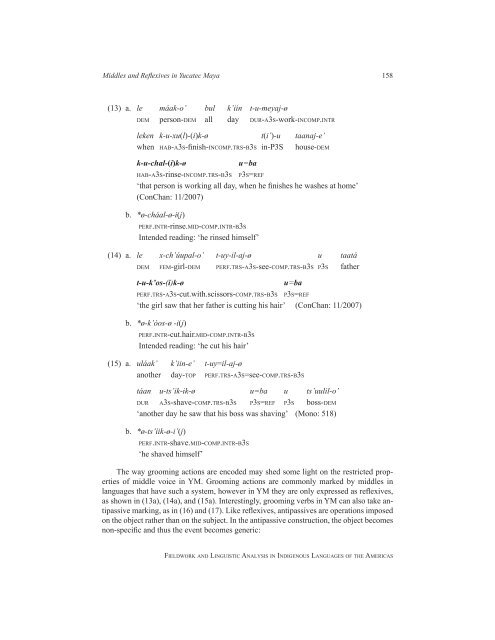Fieldwork and Linguistic Analysis in Indigenous ... - ScholarSpace
Fieldwork and Linguistic Analysis in Indigenous ... - ScholarSpace
Fieldwork and Linguistic Analysis in Indigenous ... - ScholarSpace
You also want an ePaper? Increase the reach of your titles
YUMPU automatically turns print PDFs into web optimized ePapers that Google loves.
Middles <strong>and</strong> Reflexives <strong>in</strong> Yucatec Maya 158<br />
(13) a. le máak-o’ bul k’i<strong>in</strong> t-u-meyaj-ø<br />
dem person-dem all day dur-a3s-work-<strong>in</strong>comP.<strong>in</strong>tr<br />
leken k-u-xu(l)-(i)k-ø t(i’)-u taanaj-e’<br />
when hab-a3s-f<strong>in</strong>ish-<strong>in</strong>comP.trs-b3s <strong>in</strong>-P3S house-dem<br />
k-u-chal-(i)k-ø u=ba<br />
hab-a3s-r<strong>in</strong>se-<strong>in</strong>comP.trs-b3s P3s=ref<br />
‘that person is work<strong>in</strong>g all day, when he f<strong>in</strong>ishes he washes at home’<br />
(ConChan: 11/2007)<br />
b. *ø-cháal-ø-i(j)<br />
Perf.<strong>in</strong>tr-r<strong>in</strong>se.mid-comP.<strong>in</strong>tr-b3s<br />
Intended read<strong>in</strong>g: ‘he r<strong>in</strong>sed himself’<br />
(14) a. le x-ch’úupal-o’ t-uy-il-aj-ø u taatá<br />
dem fem-girl-dem Perf.trs-a3s-see-comP.trs-b3s P3s father<br />
t-u-k’os-(i)k-ø u=ba<br />
Perf.trs-a3s-cut.with.scissors-comP.trs-b3s P3s=ref<br />
‘the girl saw that her father is cutt<strong>in</strong>g his hair’ (ConChan: 11/2007)<br />
b. *ø-k’óos-ø -i(j)<br />
Perf.<strong>in</strong>tr-cut.hair.mid-comP.<strong>in</strong>tr-b3s<br />
Intended read<strong>in</strong>g: ‘he cut his hair’<br />
(15) a. uláak’ k’i<strong>in</strong>-e’ t-uy=il-aj-ø<br />
another day-toP Perf.trs-a3s=see-comP.trs-b3s<br />
táan u-ts’ik-ik-ø u=ba u ts’uulil-o’<br />
dur a3s-shave-comP.trs-b3s P3s=ref P3s boss-dem<br />
‘another day he saw that his boss was shav<strong>in</strong>g’ (Mono: 518)<br />
b. *ø-ts’íik-ø-i’(j)<br />
Perf.<strong>in</strong>tr-shave.mid-comP.<strong>in</strong>tr-b3s<br />
‘he shaved himself’<br />
The way groom<strong>in</strong>g actions are encoded may shed some light on the restricted properties<br />
of middle voice <strong>in</strong> YM. Groom<strong>in</strong>g actions are commonly marked by middles <strong>in</strong><br />
languages that have such a system, however <strong>in</strong> YM they are only expressed as reflexives,<br />
as shown <strong>in</strong> (13a), (14a), <strong>and</strong> (15a). Interest<strong>in</strong>gly, groom<strong>in</strong>g verbs <strong>in</strong> YM can also take antipassive<br />
mark<strong>in</strong>g, as <strong>in</strong> (16) <strong>and</strong> (17). Like reflexives, antipassives are operations imposed<br />
on the object rather than on the subject. In the antipassive construction, the object becomes<br />
non-specific <strong>and</strong> thus the event becomes generic:<br />
fieldwork <strong>and</strong> l<strong>in</strong>guistic analysis <strong>in</strong> <strong>in</strong>digenous languages of the americas

















